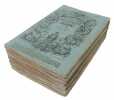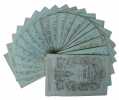"DICKENS, CHARLES.
Master Humphrey's Clock.
London, Chapman & Hall, 1840-1841. A complete run of the 20 monthly parts, uncut in the original blue green pictoral wrappers. Two parts with previous owner's name to top of front wrapper. A few of the parts with brownspots to wrappers. An overall fine set. Housed in a slipcase. Collation corresponds to Hatton and Cleaver with the following exceptions: Part 1, lacking first advertisement (out of 3), beginning with ""Rippon & Burton" Part 10, lacking advertisements" Part 11, lacking advertisements.
Reference : 60153
A fine set of first printings of the 20 monthly parts of Dickens' famous short-lived periodical, including the novels ""The Old Curiosity Shop"" and ""Barnaby Rudge"". Master Humphrey's Clock was first issued in weekly parts before being collected into monthly issues and finally into book format. Master Humphrey's Clock was one of the first works to appear in weekly as well as monthly installments. Eckel, Pp. 67-69.Hatton and Cleaver, 161-182Gimbel, A50
Bookseller's contact details
Herman H. J. Lynge & Son
William Schneider
Silkegade 11
1113 Copenhagen
Denmark
+45 33 155 335
Payment mode
Sale conditions
All items may be returned for a full refund for any reason within 14 days of receipt.
5 book(s) with the same title
Master Humphrey's Clock.
Collection complète des 20 livraisons London, Chapman and Hall, (avril) 1840 - (novembre) 1841. 20 vol. (180 x 265 mm). Broché, sous couverture bleu illustrée (emboîtage). Édition originale. L’ouvrage a paru sous trois formes : en 88 livraisons hebdomadaires, 20 livraisons mensuelles, puis en 3 volumes. Ces 20 livraisons mensuelles, complètes, sont illustrées de 3 frontispices et de nombreuses gravures sur bois dans le texte, par George Cattermole et H. K. Browne. Elles sont publiées sous d’identiques couvertures illustrées de papier bleu, les mêmes que celles des 88 livraisons hebdomadaires (du 4 avril 1840 au 27 novembre 1841).
Le Master Humphrey's Clock est entièrement écrit par Charles Dickens : un journal complet, avec une histoire principale qui présente Maître Humphrey, un Londonien solitaire d'un certain âge, collectionneur de manuscrits qu'il garde précieusement dans une vieille horloge au coin de la cheminée. Il décide un beau jour de fonder un petit cercle, «L'Horloge de Maître Humphrey », dont les membres liront tour à tour leurs manuscrits. The Pickwick Papers y prennent place, puis s'y ajoutent plusieurs nouvelles, puis les romans Barnaby Rudge et surtout Le Magasin d'antiquités, un des grands textes de Charles Dickens. Quelques rousseurs, auréoles et taches à certaines couvertures de livraison, légère restauration à la couverture de livraison n° 3. Pour le reste, très bel ensemble. Rare dans cette condition.
Master Humphrey's clock - Barnaby Rudge
London, Chapman and hall, 1840-1841. 3 tomes en 2 vol. grands in-8. Demi-veau noir à coins d'époque, dos à nerfs orné de filets dorés, pièces de titre et de tomaison de maroquin brun.
Édition originale de ce recueil de nouvelles parues à l'origine en 88 livraisons hebdomadaires sous le même titre, éditées par l'auteur d'avril 1840 à décembre 1841. Chaque volume est illustré d'un frontispice et l'ensemble contient près de 200 illustrations in-texte par George Cattermole et Hablot Knight Browne.Cette édition présente l'ensemble des textes dans l'ordre de leur parution initiale : quelques nouvelles puis les romans "Le magasin d'antiquités" (p. 37 du vol. 1) et "Barnaby Rudge" (p. 229 du vol. 2). Dès 1848, dans une préface de The old Curiosity shop, Dickens déclare que l'histoire ne doit plus être liée aux autres œuvres initialement parues dans Master Humphrey's clock. Cette édition demeure ainsi la seule réunion de ces œuvres. Ex-libris Ernest Schutte. Ex-libris O. P. Laurentii.Large déchirure sans manque restaurée à la page 81-82 du tome II. Quelques épidermures au dos.
Master Humphrey's Clock.
London, Chapman and Hall, 1840-1841. Bound in 3 uniform contemporary half calfs with gilt lettering and ornamentation to spines. Hinges with minor wear and a few nicks to the leather on the boards, otherwise a fine and clean copy.
First edition of the three-volume edition (Printed same year as the original 20 monthly parts) of Master Humphrey's Clock, a weekly periodical edited and written by Charles Dickens and published from April 4, 1840-December 4, 1841. ""The publication of these stories in the form presented was one of the first of several experiments which the Author applied to several succeeding books. Dickens feared that his readers had become weary of stories in monthly issues on account of the lapse of time between the numbers. At the request of Chapman & Hall he outlined his planspartially in a letter when he wrote among other things: ""To introduce a little club or knot of characters and to carry their personal histories and proceedings through the work" to introduce fresh characters constantly to re-introduce Mr. Pickwick and Sam Weller" x x x to write amusing essays on the various foibles of the as they form of the papers by throwing them into sketches, letters from imaginary correspondents, and so forth, so as to diversify the contents as much as possible."" (Eckel, p. 67).Hatton and Cleaver, Pp. 163-182.
Master Humphrey's Clock. With Illustrations by George Cattermole and Halbot Browne.
3 volumes. London: Chapman and Hall, 186 Strand. 1840-1841. 24,2x17,5 cm. Frontispiz, IV S., 1 Bl., 306 S., 1 w. Bl.; Frontispiz, 2 Bl., 306 S., 1 w. Bl.; Frontispiz, VI, 426 S., 1 w. Bl. Halblederbände der Zeit mit Rückenschild und etwas Rückenvergoldung.
Erste Buchausgabe. - Titelblätter verso: Bradbury and Evans, Printers, Whitefriars. - Einbände berieben. Exlibris auf Innendeckeln. Vereinzelt leicht fleckig oder eselsohrig. Vorsätze leimschattig. In Band 2 fehlt das 2seitige Vorwort. Rückengelenk eingerissen bei Band 3.
The Old Curiosity Shop and Master Humphrey’s Clock. With an Introduction by George Gissing and Notes by F. G. Kitton. Illustrated by G. M. Brimelow. 2 Volumes. The Rochester Edition.
London, Methuen 1901, 195x130mm, XXIV- 425 + 410pages, editor's binding.
Pour un paiement via PayPal, veuillez nous en faire la demande et nous vous enverrons une facture PayPal
 Write to the booksellers
Write to the booksellers







